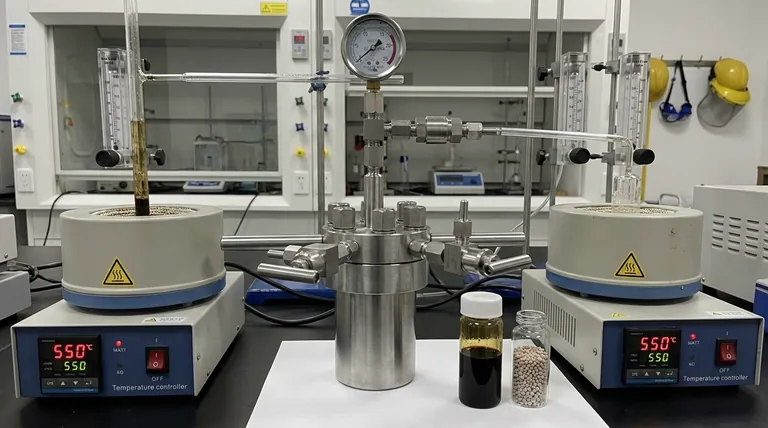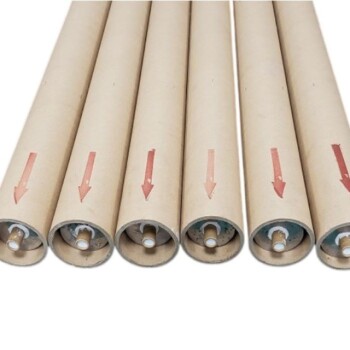In catalytic pyrolysis, the process is generally conducted at temperatures between 400°C and 650°C (750°F to 1200°F). While this falls within the broader range of traditional pyrolysis, the catalyst's role is not simply to change the temperature but to lower the reaction's activation energy. This allows for more efficient conversion and higher quality products at temperatures that might otherwise be inefficient.
The core purpose of a catalyst in pyrolysis is not to drastically lower the operating temperature, but to selectively steer chemical reactions at a given temperature. This improves the quality and yield of desired products, such as bio-oil, while reducing unwanted byproducts.

How Catalysts Fundamentally Change Pyrolysis
Introducing a catalyst transforms pyrolysis from a brute-force thermal decomposition process into a more precise chemical conversion technology. The temperature is just one variable in this more complex equation.
Lowering Activation Energy
A catalyst provides an alternative pathway for chemical reactions to occur, one that requires less energy. This means that at a given temperature (e.g., 500°C), reactions happen much faster and more completely than they would without the catalyst.
This efficiency gain is the primary reason for using a catalyst. It enables the breakdown of complex organic matter, like biomass or plastic, into smaller, more valuable molecules more effectively.
Improving Product Selectivity
Perhaps the most significant advantage is selectivity. A non-catalytic process produces a wide mixture of compounds. A catalyst, however, can be chosen to favor the production of specific valuable chemicals.
For example, certain catalysts like zeolites are excellent at converting the initial pyrolysis vapors into aromatic hydrocarbons (the building blocks for fuels and chemicals) and reducing undesirable oxygenated compounds, which makes the resulting bio-oil more stable and energy-dense.
Key Catalytic Pyrolysis Configurations
The way the catalyst is introduced into the process has a major impact on performance and temperature control. The two primary methods are in-situ and ex-situ.
In-Situ Catalysis (Mixed Reactor)
In this configuration, the catalyst is mixed directly with the feedstock (e.g., biomass) inside the pyrolysis reactor. This ensures excellent contact between the catalyst and the evolving pyrolysis vapors.
The main advantage is a simpler, less expensive reactor design. However, the catalyst is quickly deactivated by direct contact with char and inorganic ash, requiring frequent regeneration or replacement. The temperature is uniform for both pyrolysis and catalytic upgrading.
Ex-Situ Catalysis (Dual Reactor)
This approach uses a two-stage system. The first reactor performs standard pyrolysis on the feedstock. The resulting hot vapors are then fed into a second, separate reactor containing the catalyst bed.
This configuration allows for independent optimization of temperatures for both the pyrolysis and the catalytic upgrading steps. It protects the catalyst from deactivation by char, extending its lifespan, but results in a more complex and costly system.
Understanding the Trade-offs
While catalytic pyrolysis offers significant advantages, it introduces complexities and costs that must be carefully weighed.
Temperature vs. Catalyst Lifespan
Higher temperatures can increase reaction rates, but they also accelerate catalyst deactivation. Coking, where carbon deposits on the catalyst surface and blocks active sites, becomes more severe at higher temperatures. Finding the optimal temperature is a balance between product yield and operational longevity.
Cost and Availability of Catalysts
Effective catalysts, such as synthetic zeolites, can be expensive. Their cost must be justified by the increased value of the final products or the overall efficiency gains of the process.
Process Complexity and Control
An ex-situ catalytic system adds an entire reactor and associated piping, heating, and control systems. This increases the initial capital investment and the operational complexity compared to a simpler, non-catalytic pyrolysis unit.
Making the Right Choice for Your Goal
The optimal temperature for catalytic pyrolysis is dependent on the feedstock, the chosen catalyst, and the desired end product.
- If your primary focus is maximizing high-quality bio-oil yield: A moderate temperature around 500°C in an ex-situ configuration often provides the best balance of conversion, catalyst stability, and product quality.
- If your primary focus is producing specific high-value aromatics: A higher temperature (e.g., 600-650°C) with a shape-selective catalyst like ZSM-5 is often necessary to drive the required cracking and reforming reactions.
- If your primary focus is minimizing initial capital cost: An in-situ catalytic process or even non-catalytic pyrolysis may be the most practical starting point, accepting a trade-off in product quality and catalyst lifespan.
Ultimately, temperature in catalytic pyrolysis is not a fixed number but a strategic variable you control to achieve a specific chemical outcome.
Summary Table:
| Parameter | Typical Range | Key Influence |
|---|---|---|
| Temperature | 400°C - 650°C (750°F - 1200°F) | Balances reaction rate and catalyst lifespan |
| Catalyst Type | Zeolites (e.g., ZSM-5) | Determines product selectivity (e.g., aromatics) |
| Configuration | In-situ or Ex-situ | Impacts complexity, cost, and temperature control |
| Primary Goal | High-quality bio-oil or specific chemicals | Dictates optimal temperature and catalyst choice |
Ready to optimize your pyrolysis process for superior product yield and quality? KINTEK specializes in advanced lab equipment and consumables for catalytic pyrolysis research and development. Whether you're working with biomass or plastic feedstocks, our solutions help you precisely control temperature and catalyst variables to achieve your desired chemical outcomes. Contact our experts today to discuss how we can support your laboratory's innovation in sustainable conversion technologies.
Visual Guide

Related Products
- Customizable High Pressure Reactors for Advanced Scientific and Industrial Applications
- Electric Rotary Kiln Small Rotary Furnace Biomass Pyrolysis Plant
- High Pressure Laboratory Autoclave Reactor for Hydrothermal Synthesis
- Mini SS High Pressure Autoclave Reactor for Laboratory Use
- Stainless High Pressure Autoclave Reactor Laboratory Pressure Reactor
People Also Ask
- What is the role of a stainless steel high-pressure reactor in the hydrothermal synthesis of MIL-88B? Boost MOF Quality
- Does pressure affect melting and boiling? Master Phase Changes with Pressure Control
- What conditions do laboratory high-pressure reactors provide for HTC? Optimize Your Biochar Production Processes
- How high pressure is created in a lab? Master Safe and Precise Pressure Generation
- Why are the design pressure and temperature ranges of high-pressure autoclaves critical for biomass HTL processes?



















